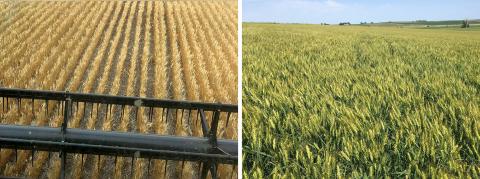Winter Wheat Varieties with an Eastern Nebraska Fit
September 27, 2018
Winter wheat growers in eastern Nebraska will want to check out the newer winter wheat varieties described here as well as a table of comparable traits to aid in selecting a variety best suited for their operation.
Should I Plant Treated Wheat Seed?
August 29, 2018
Using clean, certified, treated winter wheat seed optimizes the chances of obtaining high yields. Seed-transmitted diseases and fall insects can reduce grain yield as well as quality next summer.

Recap of 2017-18 Eastern Nebraska Winter Wheat Crop
July 25, 2018
Winter wheat yields in eastern Nebraska were quite variable in 2018, ranging from 10 to 80 bu/ac, depending on precipitation. This review of the growing season examines some of the factors affecting yields in southeast, east central, and northeast Nebraska.
Wheat Disease Update: Wheat Streak Mosaic and Stripe Rust
January 8, 2018
From the 2018 Crop Production Clinic Proceedings, this wheat disease update focuses on wheat streak mosaic virus and stripe rust.
Wheat Disease Update for Central to Western Nebraska
June 22, 2018
Wheat diseases were found at varying levels across a wide area of fields surveyed this week in western Nebraska in conjunction with the 2018 Wheat Tours.
Wheat Update: Diseases Increasing
June 13, 2018
Recent rains have created favorable conditions for disease development in wheat. If irrigating, manage applications to reduce further development and spread of diseases.
Wheat Diseases Minimal
June 8, 2018
Diseases continue to be absent or at very low levels in Nebraska wheat, with no reports of stripe rust or leaf rust and low levels of powdery mildew. Prevailing high temperatures and dry conditions in many areas have reduced the risk of significant disease development.
Wheat Disease Update — Levels Still Low
May 31, 2018
Wheat fields in southeast and south central Nebraska were green with little disease and high yield potential, based on this week's field survey. Recent rains relieved moisture stress in wheat in some areas of the state, but more rain is needed in southeast Nebraska to alleviate stress.







